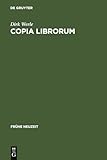Copia librorum : Problemgeschichte imaginierter Bibliotheken 1580-1630 / Dirk Werle.
Material type: TextSeries: Frühe Neuzeit : Studien und Dokumente zur deutschen Literatur und Kultur im europäischen Kontext ; 119Publisher: Tübingen : Max Niemeyer Verlag, [2012]Copyright date: ©2007Description: 1 online resource (590 p.)Content type:
TextSeries: Frühe Neuzeit : Studien und Dokumente zur deutschen Literatur und Kultur im europäischen Kontext ; 119Publisher: Tübingen : Max Niemeyer Verlag, [2012]Copyright date: ©2007Description: 1 online resource (590 p.)Content type: - 9783484366190
- 9783110942156
- 809 22/ger
- Z987 .C485 2007
- online - DeGruyter
- Issued also in print.
| Item type | Current library | Call number | URL | Status | Notes | Barcode | |
|---|---|---|---|---|---|---|---|
 eBook
eBook
|
Biblioteca "Angelicum" Pont. Univ. S.Tommaso d'Aquino Nuvola online | online - DeGruyter (Browse shelf(Opens below)) | Online access | Not for loan (Accesso limitato) | Accesso per gli utenti autorizzati / Access for authorized users | (dgr)9783110942156 |
Browsing Biblioteca "Angelicum" Pont. Univ. S.Tommaso d'Aquino shelves, Shelving location: Nuvola online Close shelf browser (Hides shelf browser)
Dissertation Humboldt-Universität Berlin 2005.
i-iv -- Vorwort -- Inhaltsverzeichnis -- Erster Hauptteil. 1. Grundlegendes -- Erster Hauptteil. 2. Historisches Präludium – Erasmus und die humanistische Bibliothek -- Zweiter Hauptteil 3. Historisches -- Dritter Hauptteil. 4. Aspekte -- Dritter Hauptteil. 5. Theoretisch-historischer Epilog – Die Konsequenz der Universalbibliothek -- Literatur -- Namensregister
restricted access online access with authorization star
http://purl.org/coar/access_right/c_16ec
Die Studie rekonstruiert die Geschichte, wie sich gelehrte Autoren des Späthumanismus mit ihren in Texten artikulierten Ideen an einem Problem abarbeiten: dem Problem, wie man die beschleunigt anwachsende Menge der Bücher und des Wissens ordnen und kanalisieren kann. In vierfacher Hinsicht schließt die Arbeit eine Forschungslücke: Erstens rekonstruiert sie den Zeitraum von 1580 bis 1630 als zentrale Periode der Geschichte imaginierter Bibliotheken. Zweitens zeigt sie so, inwiefern die Konzeption imaginierter Bibliotheken eine zentrale Rolle für die Konstruktion von Ordnungen des Wissens in der Frühen Neuzeit spielt. Drittens argumentiert die Studie dafür, dass die Geschichte von Bibliotheken in Literatur als Geschichte von Ideen gelesen werden muss, mit denen Autoren auf Probleme reagieren. Viertens macht sie deutlich, dass der Vorstellungsraum imaginierter Bibliotheken in der untersuchten Periode im Hinblick auf eine Reihe zentraler Aspekte textsortenübergreifend große Homogenität aufweist, dass es aber textsortenintern starke Traditionslinien gibt, die sich untereinander beträchtlich unterscheiden.
The study investigates imaginary libraries in literary works of the 16th and 17th centuries and their status in the context of the history of ideas. Since the invention of printing there had been a headlong increase in the production of texts, accompanied by a corresponding information overload. These were the preconditions required for certain feats of the imagination to become possible in the first place. In the form of thought-experiments, contemporary literary figures and scholars attempted to outline solutions for the urgent problems involved in imposing order on the unmanageable plethora of texts and assuring the progress of knowledge in the face of the untrammeled abundance of factual information.
Issued also in print.
Mode of access: Internet via World Wide Web.
In German.
Description based on online resource; title from PDF title page (publisher's Web site, viewed 28. Feb 2023)









